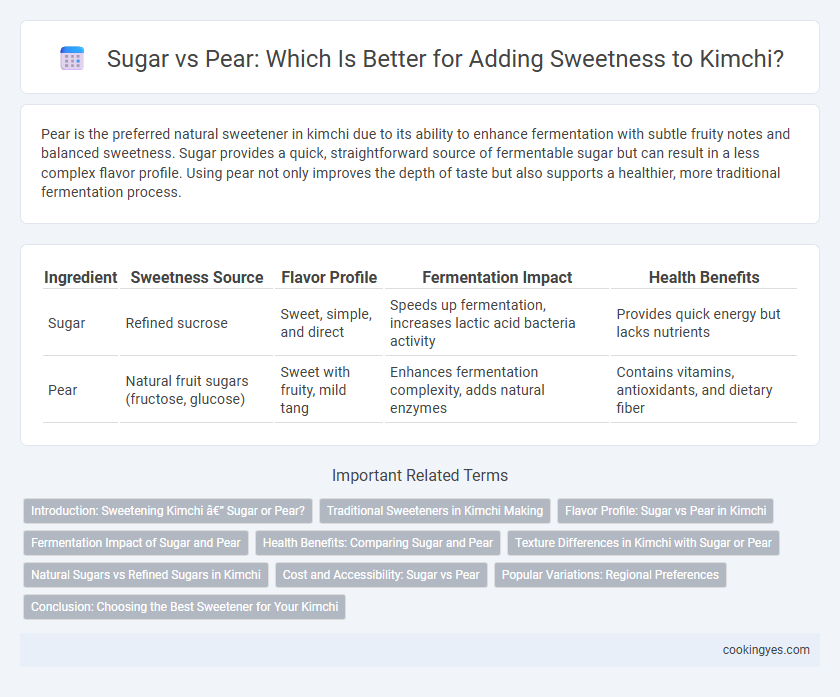Pear is the preferred natural sweetener in kimchi due to its ability to enhance fermentation with subtle fruity notes and balanced sweetness. Sugar provides a quick, straightforward source of fermentable sugar but can result in a less complex flavor profile. Using pear not only improves the depth of taste but also supports a healthier, more traditional fermentation process.
Table of Comparison
| Ingredient | Sweetness Source | Flavor Profile | Fermentation Impact | Health Benefits |
|---|---|---|---|---|
| Sugar | Refined sucrose | Sweet, simple, and direct | Speeds up fermentation, increases lactic acid bacteria activity | Provides quick energy but lacks nutrients |
| Pear | Natural fruit sugars (fructose, glucose) | Sweet with fruity, mild tang | Enhances fermentation complexity, adds natural enzymes | Contains vitamins, antioxidants, and dietary fiber |
Introduction: Sweetening Kimchi — Sugar or Pear?
Sweetening kimchi can be achieved using either sugar or pear, with each option contributing distinct flavors and fermentation dynamics. Sugar provides a straightforward, controlled sweetness that accelerates fermentation, while pear adds natural sugars alongside fruity aromas and enzymes that enhance texture. Choosing between sugar and pear impacts the final taste profile and fermentation process, influencing the kimchi's balance of sweet, tangy, and umami flavors.
Traditional Sweeteners in Kimchi Making
Traditional Korean kimchi recipes often use Asian pears instead of sugar to achieve natural sweetness, enhancing the depth and complexity of flavor through fermentation. Pears contribute enzymes and subtle fruity notes that aid in breaking down cabbage fibers, while sugar provides a more straightforward sweetening effect but lacks these fermentation benefits. Using pears aligns with authentic kimchi-making practices, emphasizing natural sweeteners that complement the probiotic qualities of the dish.
Flavor Profile: Sugar vs Pear in Kimchi
Sugar adds a straightforward, consistent sweetness to kimchi, enhancing its tangy and spicy notes without altering the texture. Pear introduces a natural, fruity sweetness that enriches the flavor complexity and contributes subtle moisture, balancing the fermentation process. Using pear can result in a slightly softer kimchi with a nuanced aroma, while sugar maintains a clean, sharp sweetness.
Fermentation Impact of Sugar and Pear
Using sugar in kimchi fermentation accelerates the production of lactic acid bacteria, resulting in a tangier and more sharply fermented flavor while potentially shortening fermentation time. Pears contribute natural sugars and enzymes that not only enhance sweetness but also promote a balanced, smoother fermentation process with subtle fruity undertones. The enzymatic activity from pears aids in breaking down kimchi ingredients, improving texture and flavor complexity during fermentation compared to the straightforward sugar addition.
Health Benefits: Comparing Sugar and Pear
Pear provides natural sweetness to kimchi while contributing dietary fiber, antioxidants, and essential vitamins that support digestion and immune function. In contrast, refined sugar adds calories with minimal nutrients and can cause blood sugar spikes, impacting metabolic health negatively. Opting for pear enhances kimchi's nutritional profile by promoting gut health and offering antioxidant properties absent in standard sugar.
Texture Differences in Kimchi with Sugar or Pear
Using pear in kimchi fermentation enhances the texture by promoting crispness and a slight juiciness, due to its natural enzymes and fiber content. Sugar, while effective for sweetness, can lead to a softer texture as it accelerates fermentation and breaks down kimchi's crunchy components more rapidly. The choice between sugar and pear significantly impacts the final mouthfeel, with pear maintaining a more structured and fresh bite in traditional kimchi.
Natural Sugars vs Refined Sugars in Kimchi
Natural sugars found in pears contribute a subtle, complex sweetness to kimchi, enhancing fermentation with antioxidants and vitamins that support probiotic growth. Refined sugars, such as white sugar, provide a quick spike in sweetness and fermentable sugars but lack nutritional benefits and can disrupt the balance of natural fermentation. Utilizing pear-derived natural sugars promotes a healthier kimchi with improved flavor depth and beneficial microbial activity compared to the basic sweetness from refined sugars.
Cost and Accessibility: Sugar vs Pear
Sugar offers a consistent, cost-effective option for sweetening kimchi, with widespread availability in most regions and longer shelf life compared to fresh fruit. Pears provide a natural sweetness and subtle flavor complexity but tend to be more expensive and seasonal, limiting accessibility and increasing overall production costs. For commercial kimchi production, sugar remains the preferred sweetening agent due to its affordability and ease of storage.
Popular Variations: Regional Preferences
Kimchi sweetness varies regionally, with sugar commonly used in southern Korea to enhance fermentation and balance spiciness, while pear is preferred in northern regions for its natural fruity flavor and subtle sweetness. The use of Asian pear, especially in areas like Gyeongsang Province, adds a unique aroma and tenderizes the cabbage, distinguishing local kimchi styles. These regional preferences highlight cultural tastes and ingredients availability influencing the traditional fermentation process.
Conclusion: Choosing the Best Sweetener for Your Kimchi
Pear provides a natural, subtle sweetness that enhances kimchi's traditional flavors while contributing enzymes that aid fermentation. Sugar offers a more straightforward and consistent sweetness but lacks the complexity and fermentation benefits found in pear. For authentic kimchi with improved fermentation, pear is the preferred sweetener, whereas sugar suits faster, less complex recipes.
Sugar vs Pear for kimchi sweetness Infographic

 cookingyes.com
cookingyes.com